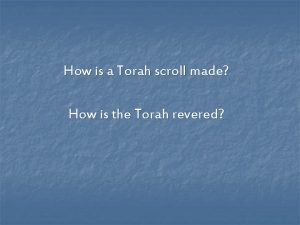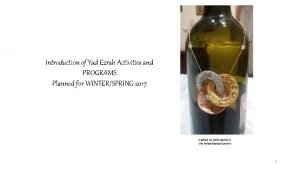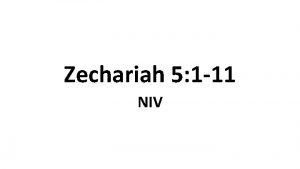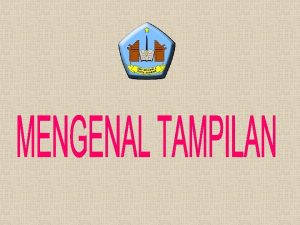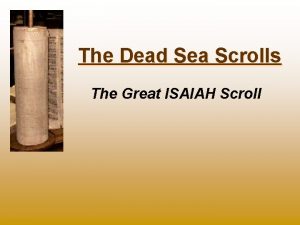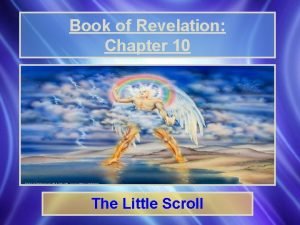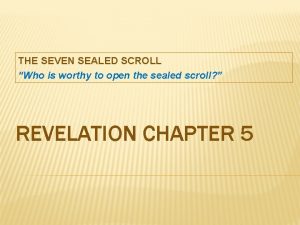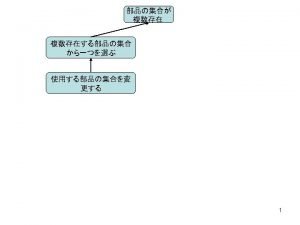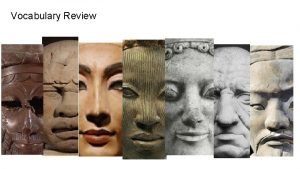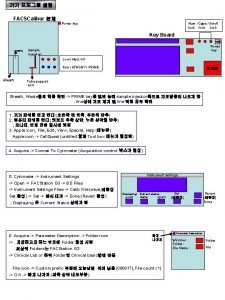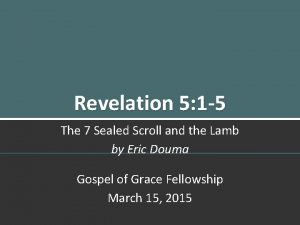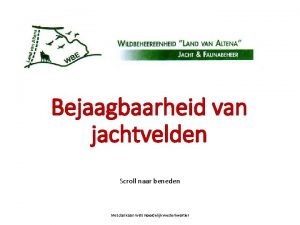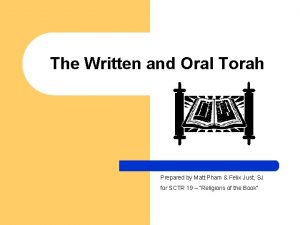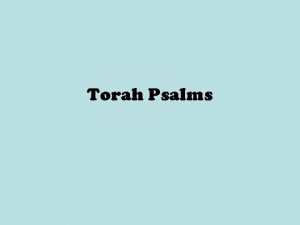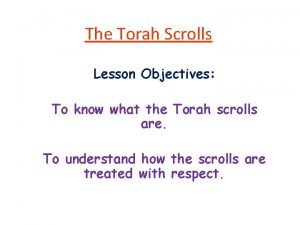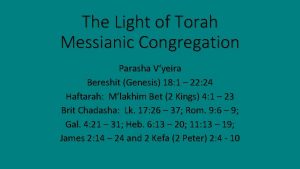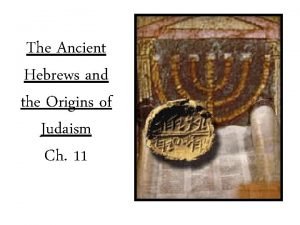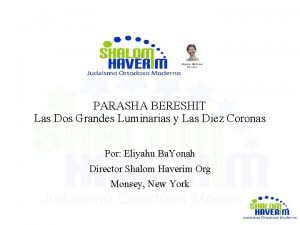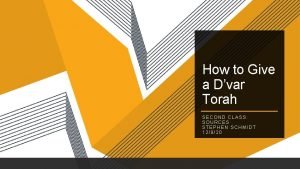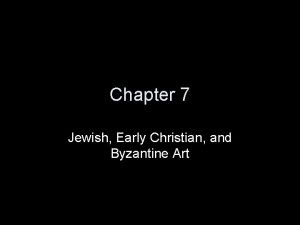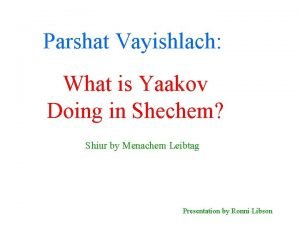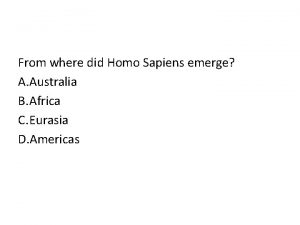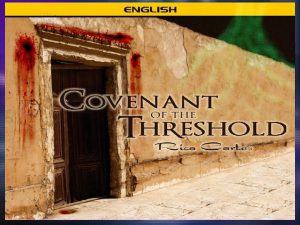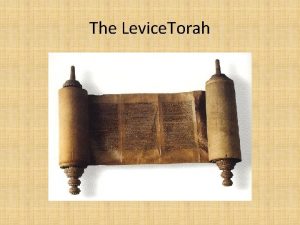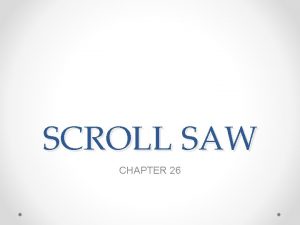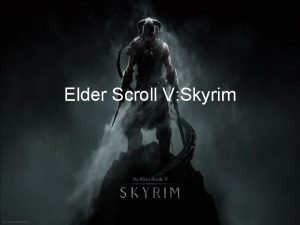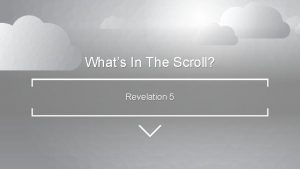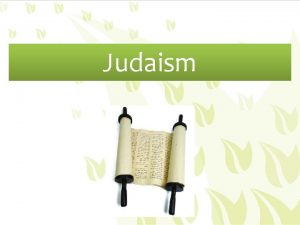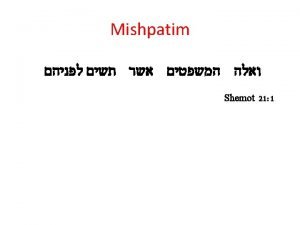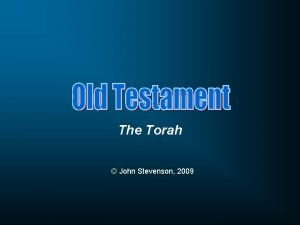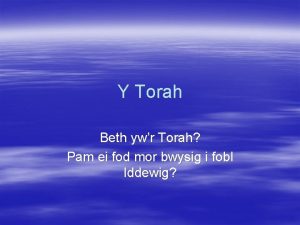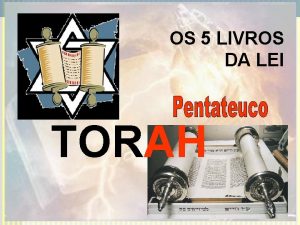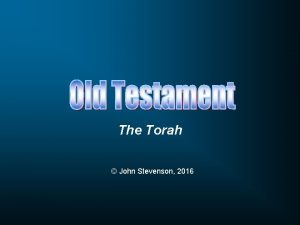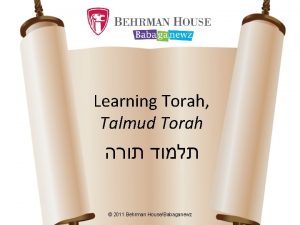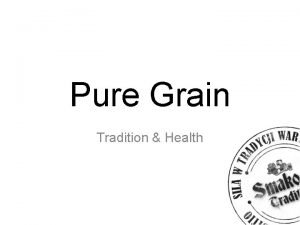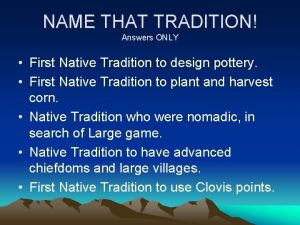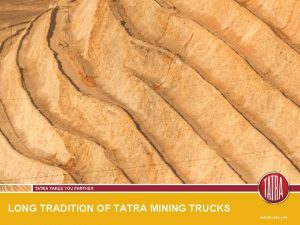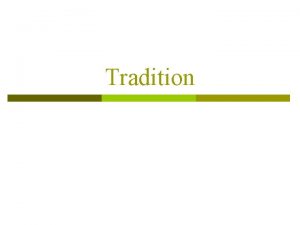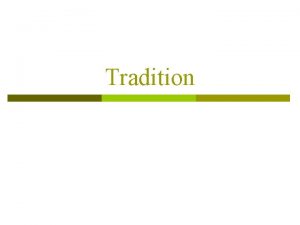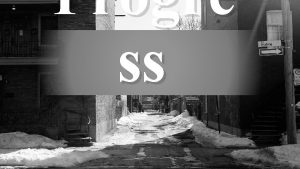The Torah and Tradition Torah Scroll and Yad






























- Slides: 30

The Torah and Tradition

Torah Scroll and Yad (pointer)

Symbol of the reestablishment of the kingdom of Judah Crown

TORAH ◦ ◦ ◦ (The Law): Bereishith (In the beginning. . . ) (Genesis) Shemoth (The names. . . ) (Exodus) Vayiqra (And He called. . . ) (Leviticus) Bamidbar (In the wilderness. . . ) (Numbers) Devarim (The words. . . ) (Deuteronomy) NEVI'IM ◦ ◦ ◦ ◦ (The Prophets): Yehoshua (Joshua) Shoftim (Judges) Shmuel (I &II Samuel) Melakhim (I & II Kings) Yeshayah (Isaiah) Yirmyah (Jeremiah) Yechezqel (Ezekiel) Written Torah is often referred to as the Tanakh, which is an acrostic of Torah, Nevi'im and Ketuvim.

The Twelve (treated as one book): ◦ Hoshea (Hosea) ◦ Yoel (Joel) ◦ Amos ◦ Ovadyah (Obadiah) ◦ Yonah (Jonah) ◦ Mikhah (Micah) ◦ Nachum ◦ Chavaqquq (Habbakkuk) ◦ Tzefanyah (Zephaniah) ◦ Chaggai ◦ Zekharyah (Zechariah) ◦ Malakhi KETHUVIM (The Writings): ◦ Tehillim (Psalms) ◦ Mishlei (Proverbs) ◦ Iyov (Job) ◦ Shir Ha-Shirim (Song of Songs) ◦ Ruth ◦ Eikhah (Lamentations) ◦ Qoheleth (the author's name) (Ecclesiastes) ◦ Esther ◦ Daniel ◦ Ezra & Nechemyah (Nehemiah) (treated as one book) ◦ Divrei Ha-Yamim (The words of the days) (Chronicles)

Pentateuch 1 st five books of the “Old” Testament (Genesis, Exodus, Leviticus, Numbers , Deuteronomy) Traditional Jewish thought: the first five books were told to Moses by God and written by Moses Theory: There are 4 different “authors” of the Penteteuch, each with his own viewpoint, style and concerns that have been blended into one book.

“J” - Yahwist “E” - Elohist “P” - Priestly “D” - Deuteronomoist God is YHWH, translated to God’s name is “Elohim, ” Yahweh, (or Jahweh), until God reveals his name translated to “The Lord” to Moses in Exodus God is Elohim and El Shaddai The source of the Book of Deuteronomy (as well as parts of Joshua, Judges, Samuel, and Kings) Informal relationship between God and people – God walks and talks with people God speaks to people in dreams; shows an awareness of God’s distance More formal, institutional relationship with God Earthly speech about God Refined speech about God Majestic speeches about God Focus on the leaders among people Stories take on narrative form, stories Refers to “ ” as the place where the commandments were given Uses genealogy lists, dry lists Refers to “ ” as the place where the commandments were given Long speeches, often retelling God’s work Focus on obedience to laws God gave to the people through Moses Focus on significance of and faithfulness to Focus on legal aspects of Israelite faith that would support a life of faithfulness to the covenant through exile and times of loss Stress is placed on people who are blessed Calls the natives Canaanites Calls the Natives “Amorites” Focus or ritual and religious Strong focus on centralized law worship Opposes intermarriage with the natives

The Ten Commandments

Interpretation of the 613 Torah laws Makes laws applicable and suitable for contemporary living. Original text at center; commentaries; crossreferences Talmud

Synagogue






Central Synagogue of New York

Perpetual Lamp / Menorah

Bimah

Torah Scrolls

Mohel

Rite of Passage

Mazel tov: The Hebrew way to say "congratulations" or "good luck. " Breaking the glass: ◦ wedding tradition. After the reciting of the Seven Blessings, the groom smashes a glass with his foot. ◦ many interpretations for the breaking of glass. ◦ represents the destruction of the Holy Temple, reminding all in attendance that pure joy can only exist once the Temple is rebuilt someday. Jewish Weddings

Ketubah The Jewish wedding contract Lists what the husband will provide for the wife

Wine cup used during ceremony Traditionally silver often the one the couple will use for the weekly celebration of Shabbat Kiddish

Chupa/chuppah Canopy with four supporting poles representing the home to be built Circling: The bride circles the groom 3 or 7 times under the chuppah ◦ This custom is thought to represent the bride's protection of the household


Tefillin

Mezuzah

Tallit Prayer Shawl The purpose is to hold the Tzitzit Purpose of the Tzitzit (according to the Torah) is a reminder of God's commandments.

A sign of respect and fear of God Separates God and human, recognizing that God is above all mankind Yarmulke
 How is a torah scroll made
How is a torah scroll made Salam contract
Salam contract Yad ezrah
Yad ezrah Flying scroll zechariah
Flying scroll zechariah Title bar adalah..
Title bar adalah.. The great isaiah scroll
The great isaiah scroll The little scroll
The little scroll Impulse-style scroll animations
Impulse-style scroll animations Sealed scroll
Sealed scroll Window scroll
Window scroll Rolled cookies definition
Rolled cookies definition Arduino uno mouse
Arduino uno mouse Horizontal scroll
Horizontal scroll Who is this?
Who is this? Num caps scroll
Num caps scroll 7 sealed scroll
7 sealed scroll Horizontal scroll
Horizontal scroll Scroll naar beneden
Scroll naar beneden Written and oral torah
Written and oral torah Torah psalm
Torah psalm Why is the torah important
Why is the torah important Parasha messianic torah
Parasha messianic torah What is the torah
What is the torah Parasha bereshit
Parasha bereshit Parasha bamidbar zohar
Parasha bamidbar zohar Dvar torah meaning
Dvar torah meaning Parasha shemot
Parasha shemot Wall with torah niche
Wall with torah niche Parshat vayishlach dvar torah
Parshat vayishlach dvar torah Torah is the sacred book of
Torah is the sacred book of Rico cortes
Rico cortes
